#Educational techniques
Text
Meaningful Learning in Malay Language: Primary School Remedial Education
INTRODUCTION
In this age of globalization, the world community has received various changes influenced by the development of technology. Industry and education in a country will be affected because the services provided are for the improvement and change of a community or society that now receives technological skills. All information or info is shared with various technology mediums that can be…
View On WordPress
#Educational techniques#Effective learning methods#Language learning facilitation#Language skills development#Malay language learning#Meaningful learning strategies#Primary school education#Remedial education#Student engagement#Teaching Malay language
0 notes
Text
Rope Techniques ~ Tying without a partner
Here are a couple of tactics I have utilized in practicing shibari when I'm not able to work with a partner
First: Here's how I added "elbows" to my plastic mannequin to enable her to be placed into a gote or box position


The arms of my mannequin disconnect at the shoulders, so I started by removing them and then sawed them apart at the elbow
Next, I stuffed both open ends of the plastic arm halves with foam pool noodles I had on hand
I connected the stuffed arms by running bent lengths of wire hangers into the pool foam to act as a semi-adjustable joint
Finally, I wrapped and secured both new joints with a length of ace bandage and some duct tape - I dress my mannequin in a body suit so the rope has something to grip; the plastic mannequin skin lacks the toothsomeness of human flesh

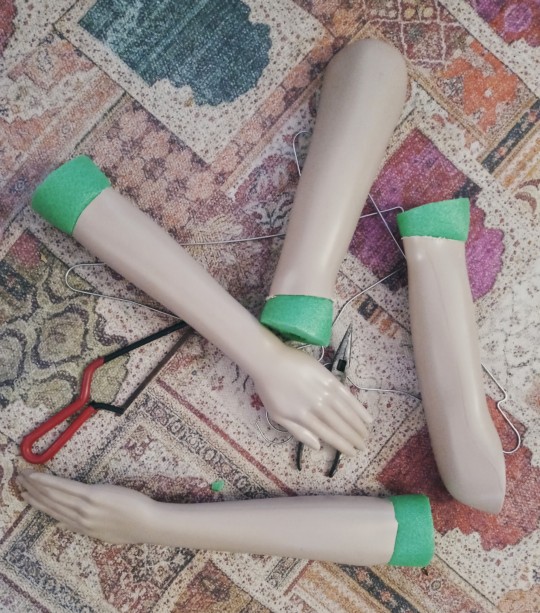


Second: a simpler and very similar effect can be achieved for gote/tk practice without a mannequin. You can throw a hoodie over a full-backed chair, such as a kitchen chair, and stuff a rolled towel inside the joined arms of the hoodie as pictured below:


Sometimes we cannot tie with a partner. These pictures were taken during the COVID lockdowns, for example.
And while these inanimate accommodations cannot take the place of partnered learning, they have helped me to advance my understanding of patterns and builds and rope handling along the way and I hope they may be of use to some of you too!
*This is the mannequin I modified above which was gifted to me by my SO*
#shibari#rope techniques#partner free tying#tying without a partner#learning the ropes#mannequin#thoughts on rope#kink education#practice makes progress
315 notes
·
View notes
Text
Ways to actually start studying after procrastinating
Don't multi-task: Multitasking does not come in the form of making notes and watching Netflix, it can come in the form of switching between two or three subjects too many times then it is like washing a plate and watching a show. It barely makes any sense to me.
Batching: Batching is where you take your to-do list and batch similar tasks into groups and take a break in between these batches.
Do Not Use Pomodoro Technique: Don't use the Pomodoro Technique because you have fixed tasks (tasks that require a particular amount of time) and flexible tasks (tasks that might take up more time than fixed tasks).
Flashcards: These things are the gamer-changers. Flashcards can be used in subjects which have a lot of terms that you need to remember, such as biology, chemistry,etc.
Don't feel bad about modifying your to-do list: If you have your math homework and an exam due next week, and you don't feel like doing math then you could study for your exam. Its okay to modify your tasks according to your mood.
Bonus tip: If you have to revise a chapter, get a few blank pages and put it beside your textbook/notes. While reading your notes, write down points that you can't remember or think is important that you wanna recap later on. If you compile those papers up that could be your go-to revision booklet before your exams.
#school#student life#study tips#studying#education#study#study aesthetic#study mode#study movitation#study space#study studying studygram studyblr studyabroad studyhard studyspo studymotivation studytime studyinspiration studyinspo studyaccount studyblo#study time#study techniques#study tumblr#studystudystudy#studysthetics#studyblr#study blog#studybrl#study studyblr#study motivation#study advice#study academia#studyspo#studyspiration#studyquill#studywithvictory#studyinspo#study inspiration#studyonline
108 notes
·
View notes
Text
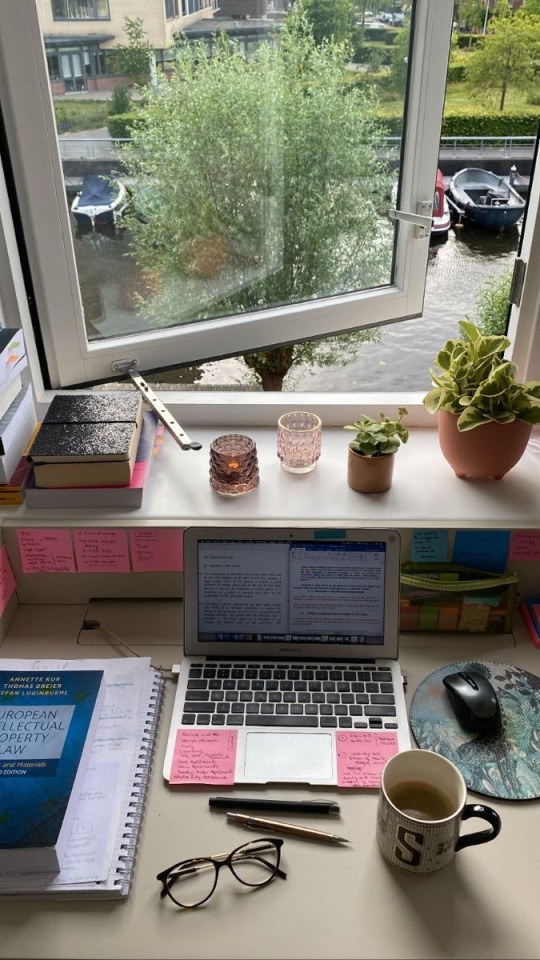

how to revise effectively
revision is a very important part of education, but many people have no idea how. in this post i'm going to outline the basics of revision. it's important to note that different subjects will require you to revise differently, there is no one size fits all when it comes to revision.
less is more- studying for 30 focused minutes is way more effective than a 5 hour study session while you watch tv.
work on exam technique- this is such an overlooked part of revising for an exam, but if you know how to answer the questions and what structures to use, it will really help you. ask your teacher or search for your exam board online to find out the best way for your subject and exam board.
manage distractions- if like me you get distracted super easily, you need to create an environment with limited distractions. this means put your phone on do not disturb, if your house/place of study is noisy put some headphones on and listen to classical music or study ambience (my favourites are the Harry Potter rooms by Asmrweekly on youtube). if you get distracted while studying by thinking of things you need to do, something that's really helped me is to have a piece of paper next to me that i can write all my thoughts on, so i can continue studying and do what i've written afterwards.
set precise goals for your study session- this helps to reduce procrastination. for example, if I put "study geography" on my to do list i'll procrastinate, but if I put "do 30 flashcards for the topic hazards" I have a clear idea of what I need to do
use the pomodoro method- having breaks is really important in keeping you engaged while you're studying. I don't follow the typical timings, but I usually do between 30-45 minutes of studying followed by a 10-15 minute break depending on how I'm feeling
utilise your study breaks- it's so easy to pick your phone up and scroll through tiktok until you realise your 5 minute break turned into a 3 hour tiktok binge. when I go on a study break, I only go on my phone to snap people back, or for a little scroll on pinterest. I also like to get some more water, grab a snack and stretch. If I'm having a longer break, I'll try to get outside and go for a walk, especially if the weather is good (in England this is about 5 days of the year haha)
now, onto different ways to revise
doing past papers
doing flashcards
making timelines
doing essay plans
making mindmaps
blurting
quizzes
if you study languages, practicing translations or specific types of questions that come up in the exam (for my exam board this is things like gap fill activities, 90 word listening or writing summaries, finding synonyms in a text etc.)
#studying#healthy eating#exercise#healthylifestyle#reading#sixth form#high achiever#high school#exam season#exams#exampreparation#pomodoro method#past papers#mind map#timeline#revision#study blog#study motivation#student#study aesthetic#study goals#exam tips#exam technique#education#education system#work hard#quizzes#language study#language student#university
54 notes
·
View notes
Text
The Feynman Technique

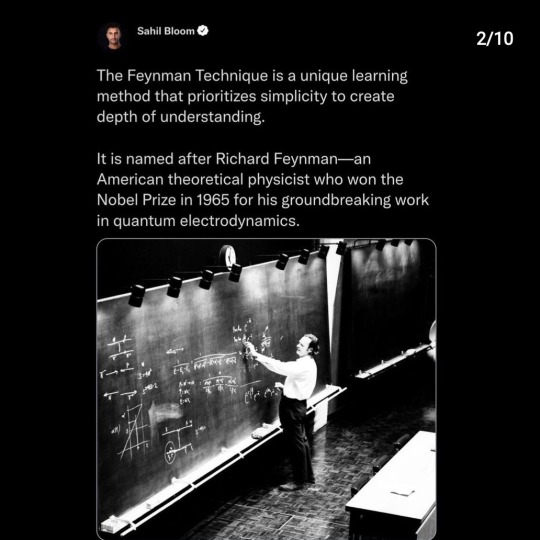








#feynman technique#learning#the art of learning#never stop learning#autodidact#autodidactism#autodidactic#education#learning passion#feynman#simplicity#beauty of simplicity#simple#turning the unfathomable into fathomable chunks#by using analogies of everday stuff#analogies#analogy#power of analogies#power of comparisons#similarity
411 notes
·
View notes
Text
Twitter: Wilbur didn't do anything! There's no proof!
Wilbur in his apology:
"this persons feelings are completely vaild"
"These actions caused alot of pain to my ex-girlfriend"
"I have come to realise how much my past behaviour hurt this person"
(Realise Google definition: become fully AWARE of (something) as a fact; understand CLEARLY)
"I understood from our numerous conversation [...] consensual" followed by "while I may have perceived our interactions differently, I recognise that has processed and expressed feeling of hurt"
His "I understood" turns to a very uncertain "I may have perceived" - the additional "may have" making him seem not very confident in what he's saying.
He's confident in the things that make him look better but not confident when it comes to the overall overview of the situation because he saw it different.
He recognised that he had done something bad. This is from his apology himself!
But The Looky why are you taking apart quotes?
Wilbur Soot, on multiple occasions, has stated that he is an English Major (he literally wrote most the dsmp scripts), so why would an English major international use this type of wording.
Because when you take it apart, it makes him seem more confident in himself and pushes that he's not confident in her 'allegations'
His lack of confidence and acknowledgment is a divisive move by Wilbur to capitalise on his vulnerable fans and audience to make them believe in him more. The MEDIA and NEWS do this all the time.
It creates a "if he doesn't know what he's talking about then he didn't do it vibe" or a plain display ignorance, to make him look better.
And he made an apology UNPROMPTED, like when shelby said her ex she didn't say Wilbur.
It could have been an ex before or after him, if it wasn't him then he wouldn't need to apologise and could've been like "Hey that's not me!"
He didn't. He said it was him by making a response. Why apologise for something you didn't do?
You could argue that Shelby was a "terrible partner" or "used him for his clout" but on what basis?
If she was a terrible partner that's make a pair, and there is a bunch of evidence that support the fact that Wilbur behaves the way BOTH HE AND SHE HAVE STATED.
And if she was "using him for clout" then he could have been like, "Hey I don't like you. I don't want to stream with you anymore"
But then he joined Origins Smp and Shelby was there, they were both ghost, he goes out of his way to interact with her.
Your gonna act like if Wilbur told Tommy he was uncomfortable with Shelby being there, Tommy would have said no? Really?
And in the some Wilbur / shelby streams Wilbur was at her house.
Wilbur would have been better of saying his apology was AI generated and to have written a new one with he excuse, "he was in a rush"
#wilbur soot support#wilbur soot situation#Wilbur Soot#Discourse#shelby support squad#shelby support#shelby shubble#Mcyt#controversial#tw// abuse#HE IS AN ENGLISH MAJOR. HE KNOWS WHAT PERSUASIVE AND CONTROLLING LANGUAGE TECHNIQUES ARE AND HOW TO WRITE THEM-#HECK IN BRITISH EDUCATION YOU HAVE TO WRITE 3 ESSAYS IN 2 HOURS WHICH DISOLAY PERSUASIVE LANGUAGE TO CONVINCE THE MAN MARKING IT#IT IS A HIGH SCHOOL LEVEL REQUIREMENT TO BE PERSUASIVE I AM NOT JOKING THEY TEACH YOU THIS IN SCHOOL
29 notes
·
View notes
Photo




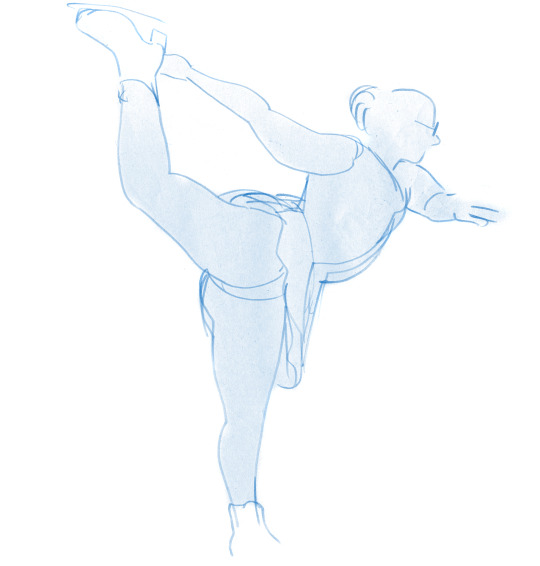



life drawing with friends : ice skating edition!! thanks to the great Anaïs who came with her outfit and ice skates :) and kept the pause with her legs up there for a couple minutes, which, how. I was very impressed and very grateful to get to draw it
#she did the whole routine : putting on one skate#then the other#then tying up the hair#there's a few poses i didn't post here but she was so good#was very much thinking about amarguerite's stories while drawing#ice skating#figure drawing#the last pose i drew the arms wrong by the way#she was doing this specific technique the name escapes me#i ran out of time and added the second arm too low but she was doing it properly#also we asked lots of questions while drawing it was both fun and educating#hehe
152 notes
·
View notes
Text
Exam Revision Progress
I swear, sometimes revision is the most exhausting phase in any high school year T-T


Please don't mind my messy notes, for some reason my brain cannot just process neat notes. It's like we're enemies but nevertheless, I managed to finish quite alot and tomorrow is another long day :")
#study motivation#studyblr#school#exams#exam season#Studying#study notes#study progress#studying tips#studyspo#study blog#study aesthetic#study with me#student#study techniques#high school studyblr#education#study tips#study rant#studyblr community
40 notes
·
View notes
Text
#Garashir#Ds9#All of these have basis in their characterization or Cardassian culture#To elaborate on the teacher thing they do play with Garak instructing Julian#With the whole 'giving him a political education' thing and Garak teaching him surveillance techniques plus the age gap#So it's not a strong vibe but it's definitely there
164 notes
·
View notes
Text

“Three Moments,” Vengeance of the Moon Knight (Vol. 2/2024), #8.
Writer: Jed Mackay; Penciler and Inker: Devmalya Pramanik; Colorist: Rachelle Rosenberg; Letterer: Cory Petit
#Marvel#Marvel comics#Marvel 616#Vengeance of the Moon Knight#Vengeance of the Moon Knight vol. 2#Vengeance of the Moon Knight 2024#Moon Knight comics#Moon Knight#Marc Spector#alright this is preferable to the forehead carving thing that people will never let go#but it makes me wonder#did Marc do any tagging during his rebellious youth???#or did full-grown and over-educated in the arts of war and espionage Marc have to figure out basic tagging techniques
10 notes
·
View notes
Text
Mean Ninjas

Survival Techniques by Tobirama.
#mean girls#tobirama senju#hiruzen sarutobi#hiruzen#kagami uchiha#kagami#uchiha#tobirama#senju#danzo shimura#homura#utatane koharu#utanate#koharu#akimichi torifu#torifu#funny#film#Survival Techniques#sex education
122 notes
·
View notes
Text
Meaningful Learning in Malay Language: Primary School Remedial Education
INTRODUCTION
In this age of globalization, the world community has received various changes influenced by the development of technology. Industry and education in a country will be affected because the services provided are for the improvement and change of a community or society that now receives technological skills. All information or info is shared with various technology mediums that can be…
View On WordPress
#Educational techniques#Effective learning methods#Language learning facilitation#Language skills development#Malay language learning#Meaningful learning strategies#Primary school education#Remedial education#Student engagement#Teaching Malay language
0 notes
Text
Rope Techniques ~ Single Column Tie ~ Cast + Feed
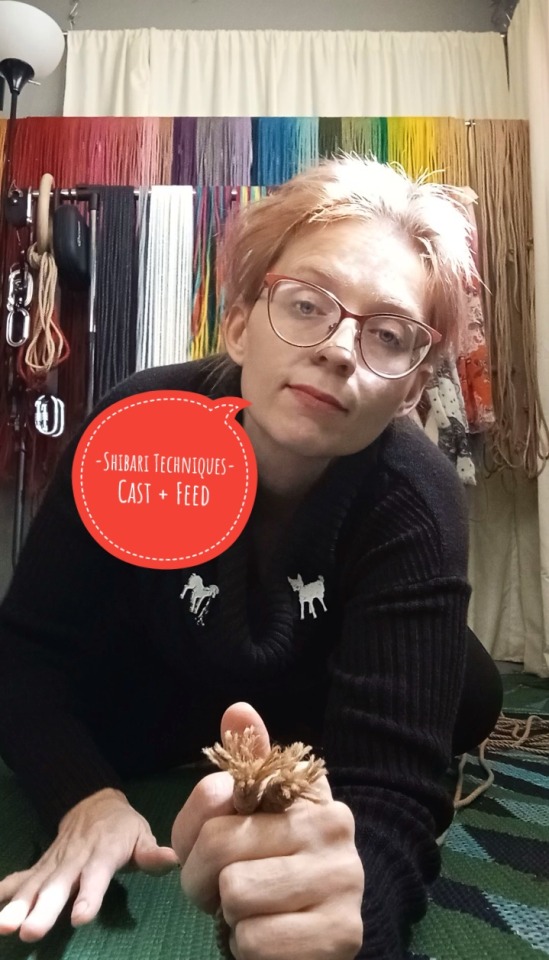
Let's take a closer look at the hand movements I use when creating a single column tie with forward tension - In this video I drill a series of single column ties on my calves and breakdown the simultaneous movements I'm making - these techniques are the same I utilize when I tie an SCT on a partner:
Maintain equal tension
Protect the skin from friction
Establish and improve muscle memory
Practice fluidity in creating a flow between my two hands
Here's to the ties that bind us 🪢❤️
#shibari#learning the ropes#rope techniques#rope tutorials#kink education#single column tie#rope video#education#praxis
40 notes
·
View notes
Text
The Study Trick that made me a topper in my school.
Imagine that your exams are approaching in a few days and you don't have any time to make any sort of notes.
Then follow this trick,
Whenever you finish reading a paragraph of any chapter of your subject, you will make a list of questions based on that paragraph (remember to frame them like an examiner). And beside those questions write the page number of the answer. In that way, you are making notes of questions while studying. And during the revision session you don't have to re-read the entire chapter, you will refer to the notes of your questions.
#study motivation#student life#study#studying#study aesthetic#study blog#study notes#studyblr#student#studyspo#study space#studyspiration#study mode#study movitation#study advice#study academia#school#exam season#exams#study tips#study techniques#study time#study table#education#textbooks#study studyblr#studystudystudy#study studying studygram studyblr studyabroad studyhard studyspo studymotivation studytime studyinspiration studyinspo studyaccount studyblo#study struggles#studysthetics
43 notes
·
View notes
Text
How to create self-help guides with the help of ChatGPT
by Mono and Sayuri from the Philosopher System
This is the comprehensive manual on how I use AI that I promised.
Using AI for Self-Help: Empowerment with Caution
In today’s fast-paced world, AI is emerging as a valuable tool for self-help, offering personalized support and guidance at any time. With platforms like ChatGPT, people managing mental health challenges like Dissociative Identity Disorder (DID) or Schizophrenia can craft their own self-help guides, gain insights, and develop coping strategies that are unique to their needs. AI can act as a supportive companion, helping you navigate complex emotions and organize your thoughts—empowering you to take control of your mental wellness.
But while AI offers a wealth of potential, it's important to approach it with caution. Like any tool, AI is not infallible. It can misunderstand your intentions, provide inaccurate information, or suggest advice that doesn’t fully align with your needs. This is why adding safety measures, like setting boundaries for your interactions, is crucial when using AI for self-help. By establishing these safeguards, you can reduce the risk of being triggered or overwhelmed and ensure that your journey with AI remains supportive.
As you explore AI for self-help, remember: AI is here to assist you, not replace human connection or professional support. Use it as a guide—knowing that while it can be incredibly helpful, it’s essential to stay mindful, question its advice, and trust your own instincts above all.
If you’re curious about how to create a personalized self-help guide using ChatGPT, this chatlog is directly linked so you can see exactly how I’ve collaborated with AI to develop one, step-by-step. Dive in and explore the process for yourself!
Important Links:
Section 0: Setting Up ChatGPT to Avoid Triggers
Before you begin using ChatGPT to create self-help guides, it’s important to ensure that your interactions with the AI are safe, supportive, and free from triggers. This section will walk you through a few strategies to set up your ChatGPT experience in a way that minimizes the risk of emotional distress or unwanted triggers, especially when managing Dissociative Identity Disorder (DID), Schizophrenia, or any other mental health challenges.
1. Set Default Instructions with Personalized Settings
Access ChatGPT Settings: On your PC, click on your profile (seen as your profile picture), go to "Settings," "Personalization," and then click on "Custom Instructions."
Set Permanent Instructions: In this section, you can tell ChatGPT to always remember certain preferences across all conversations. For example, you can instruct ChatGPT to avoid specific triggers or use gentle language without having to repeat these instructions every time.
Example: You can tell ChatGPT, "Always avoid discussing detailed trauma unless I specifically bring it up," or "Always use supportive language when discussing grounding techniques."
2. Recognize Your Triggers. With General Tips.
Reflect on Past Experiences: Take some time to think about specific words, topics, or types of responses that might trigger negative emotions or episodes for you. Knowing these upfront will help you avoid triggering content.
Make a Trigger List: Write down a list of things that commonly trigger you. These could be certain topics (like trauma), language (such as harsh or clinical terminology), or emotions (like anxiety or panic).
Example: If discussing past trauma is overwhelming, note that you want to avoid detailed conversations about trauma unless you initiate it.
3. Establish Boundaries with ChatGPT
State Your Boundaries Clearly: Start each interaction by telling ChatGPT exactly what you want it to avoid. You can let it know about specific triggers or ask for responses in a certain tone or style to avoid discomfort.
Communicate What You Need: Be direct in your instructions, so ChatGPT knows exactly how to approach the conversation. Setting clear expectations upfront helps the AI provide responses that are supportive and safe.
Example: "I’m working on managing my mental health and I’d like you to avoid discussing detailed trauma or any harsh language that could be triggering for me."
4. Use Positive and Safe Language in Prompts
Frame Your Requests Carefully: When asking for help, choose language that makes you feel comfortable. Request ChatGPT to use a calm, supportive, or encouraging tone when responding to your prompts.
Guide the Response Tone: By using words like "supportive," "positive," or "gentle," you can influence ChatGPT to keep the tone safe and reassuring.
Example: "Can you help me with grounding techniques using supportive and gentle language?"
5. Start Every Conversation with a Disclaimer
Give Context About Your State: Begin each conversation by letting ChatGPT know about your current emotional state and the topics you’d prefer to avoid. This disclaimer helps to keep the interaction safe.
Set Boundaries in Each Chat: Remind ChatGPT of what not to discuss or how to approach sensitive topics to avoid surprises during the conversation.
Example: "I’m feeling vulnerable today, so please avoid discussing anything that might be distressing. Let’s keep the conversation focused on calming techniques."
6. Ask for Calming Responses When Needed
Redirect to Grounding Techniques: If you start feeling overwhelmed, you can directly ask ChatGPT to provide grounding techniques or calming responses to help you regain control.
Change the Tone Mid-Conversation: ChatGPT can adjust its response style to match your emotional needs at any point during the conversation, helping to reduce anxiety.
Example: "I’m starting to feel anxious. Can you guide me through some breathing exercises or help me focus on something calming?"
7. Pause and Take Breaks When Necessary
Pause the Conversation: If a discussion feels overwhelming, don’t hesitate to pause the conversation. Let ChatGPT know you need a break, and you can come back when you feel more ready.
Change the Subject: If the conversation feels too heavy, you can ask ChatGPT to shift to a lighter, more positive topic.
Example: "I need to take a break for a moment. When I return, can we discuss something positive or light?"
8. Fine-Tune ChatGPT Responses Over Time
Observe and Adjust: As you continue using ChatGPT, you’ll get a better sense of what works for you. Over time, you can refine your interactions to make them more tailored to your needs.
Use What Works: After a few interactions, let ChatGPT know what helped in the past and ask it to build on those positive experiences.
Example: "Last time we talked about grounding techniques, and it helped. Can we do something similar today?"
9. Save Helpful Conversations for Future Use
Create a Resource Bank: When ChatGPT gives a particularly helpful or calming response, consider saving that conversation or part of it. You can refer back to it when you need a reminder or guidance.
Build a Safe Space Archive: Over time, you can save a collection of responses that are effective in grounding you. This acts as a personal resource library.
Example: Save conversations about guided breathing exercises, self-soothing techniques, or positive affirmations.
10. Ask ChatGPT to Rephrase or Clarify When Needed
Request Softer Responses: If ChatGPT’s response feels unclear or uncomfortable, ask it to rephrase the message. You can guide it toward using a more supportive or calming tone.
Correct the Tone: Don’t hesitate to ask ChatGPT to reword something if it feels too direct or intense. You can request it to use positive, gentle language.
Example: "Could you rephrase that in a more supportive tone? I’d like it to feel more positive."
11. Trust Your Feelings and Redirect Conversations
Follow Your Intuition: If anything feels wrong or overwhelming, trust yourself to redirect the conversation or stop interacting with ChatGPT. You are in full control of how the conversation goes.
Adjust Conversations as Needed: If you feel uncomfortable, don’t hesitate to change the subject or stop the conversation entirely. Guide ChatGPT to more comfortable, calming topics.
Example: "I think I need to change the topic to something more calming. Can we discuss mindfulness instead?"
Section 1: How to Engage with ChatGPT Like Mono Does
When I (or Mono) use ChatGPT, it’s not just about asking questions; it’s about creating a meaningful dialogue. You can use ChatGPT as both a thinking partner and an assistant. Here are the types of prompts I use, and how they can help you create self-help guides.
1. Start with Deep Personal Reflection
ChatGPT works best when you lead with personal insight. Start by sharing something about yourself, a problem you’re facing, or a goal you want to achieve. This makes the conversation with ChatGPT more meaningful, and it allows the AI to give responses tailored to your specific needs.
How I Do It:
I might say something like, "I'll tell you more about myself, Mono. Every song I make is a key to my emotions and hidden memories regarding it. I carefully craft those keys…"
Why It Works:
This kind of prompt tells ChatGPT a little about what’s going on inside your head or what you’re working on. When you open up like this, ChatGPT can give you responses that are grounded in what you care about.
How You Can Do It:
Before jumping into questions or instructions, start by sharing your thoughts. Tell ChatGPT what you’ve been feeling lately or what issue you’re trying to solve. For example, "Lately, I’ve been struggling with focus because of my dissociation. Can you help me create a guide on staying grounded throughout the day?"
2. Ask for Structure and Guidance
One of the great things about ChatGPT is that it can help you organize your thoughts. If you’re like me and sometimes need help breaking down complex ideas into simple steps, this is where ChatGPT shines.
How I Do It:
I often ask ChatGPT to help me create step-by-step guides. For example:
"Write me a detailed manual targeted at people that have autism on how they can interact with AI the same way we do."
Why It Works:
ChatGPT is really good at taking complex ideas and breaking them into smaller, easier-to-understand chunks. You can use this ability to write self-help guides that are clear and easy to follow.
How You Can Do It:
Once you’ve shared your situation, ask ChatGPT to help you break things down into steps. For example, "Can you help me break down a daily routine that will help me stay on track, especially when I feel overwhelmed?" or "Can you create a step-by-step guide for me to follow when I feel like I’m losing touch with reality?"
3. Get Feedback and Refine
Your self-help guide doesn’t need to be perfect on the first try. Just like I do, you can keep coming back to ChatGPT for feedback or to refine what you’ve written.
How I Do It:
Here’s an example of how I might check my work:
"Access all scientific literature like books, studies, and patents to check if any information in here regarding paranoia is deeply wrong or really new and helpful advice."
Why It Works:
ChatGPT can act like a second pair of eyes, reviewing your guide for clarity, accuracy, or simply helping you improve it. You can always go back and ask for ways to make it better.
How You Can Do It:
Once you’ve drafted a part of your self-help guide, ask ChatGPT to review it. For example, "I’ve written this guide about managing my DID episodes. Can you check if it makes sense and suggest any improvements?" or "Here’s my morning routine for dealing with hallucinations—how can I make it more effective?"
4. Incorporate Research (If It Helps)
If you want your self-help guide to be backed by science or trusted resources, ChatGPT can help you with that too. This doesn’t always have to be a huge research project—just simple verification can make a big difference.
How I Do It:
I’ll often ask ChatGPT to compare my knowledge with existing research, like this:
"Access all modern books regarding schizophrenia and paranoia in general, seeing if any of my knowledge doesn't exist in there and list the knowledge that doesn't exist inside scientific literature yet."
Why It Works:
This helps me make sure that my self-help guides are not just based on my experiences but are also grounded in facts or useful insights from research.
How You Can Do It:
If you’re writing about something like grounding techniques, coping with symptoms, or working through trauma, ask ChatGPT for research-based advice. For example, "Can you tell me what scientific research says about grounding techniques for dissociation?"
5. Tailor the Guide to Your Specific Needs
The more specific your prompts are, the more tailored your self-help guide will be. Don’t be afraid to ask ChatGPT for help with very detailed or unique situations.
How I Do It:
Here’s how I might personalize a request:
"Explain to me what Mono should do regarding this problem based on my knowledge and experiences with paranoia and the schizophrenia I experienced. Make it deeply intellectual."
Why It Works:
The more personal and specific the information you give, the more detailed and relevant ChatGPT’s response will be. It can help you work through issues that are unique to your situation, whether it’s related to your alters in DID or specific symptoms in Schizophrenia.
How You Can Do It:
If you have a specific issue you’re working through, ask ChatGPT to tailor the advice to that situation. For example, "Can you help me write a guide for when I’m switching between alters and need to stay grounded?" or "How can I cope with hallucinations that happen at night?"
Section 2: How to Write Your Self-Help Guide with ChatGPT
Now that you’ve got a sense of how I use ChatGPT, here’s how you can turn it into a step-by-step process for writing your own self-help guide:
Section 3: Expanded Checklist for Using ChatGPT to Create Your Self-Help Guide
Here’s a 10-step checklist to make sure your guide is not only well-designed but also helpful and correct:
Section 4: How to Write a Prompt Like Mono Does
One of the key aspects of using ChatGPT effectively is knowing how to write prompts that get you the right kind of help. Based on my analysis of how Mono writes prompts and our ongoing conversation, here are five types of prompts, along with an expanded structure, that you can use to get the best results when creating your self-help guide. Each type of prompt is tailored to help you reflect on personal needs, structure content, and refine the self-help process.
Section 5: How I Use ChatGPT – A 10-Step Guide
Based on the detailed analysis of our chatlog and how you use ChatGPT, I’ve created a concise 10-step list summarizing your method for interacting with AI to create self-help guides. This list will act as a quick reference on how to effectively engage with ChatGPT.
Reflect: Start by sharing personal thoughts or challenges.
Contextualize: Provide background information for clarity.
Ask: Pose clear, focused questions or requests.
Tailor: Customize prompts based on specific needs or experiences.
Structure: Request step-by-step guidance or organization.
Review: Ask for feedback on drafts or ideas.
Refine: Iterate based on suggestions or new insights.
Research: Incorporate external knowledge or studies.
Simplify: Break down complex topics into manageable steps.
Personalize: Ensure solutions are directly applicable to your life or goals.
Section 3: Checklist for Using ChatGPT to Create Your Self-Help Guide
Here’s a 10-step checklist to make sure your guide is not only well-designed but also helpful and correct:
[ ] Start with Personal Reflection: Did you begin by clearly stating the problem or experience you’re addressing? Make sure it's something that matters to you personally.
[ ] Clear Structure: Does your guide have a step-by-step format? Each section should build logically on the previous one, making it easy to follow.
[ ] Specific to Your Needs: Is the guide tailored to your unique situation or system? Ensure that the advice or steps are relevant to your personal experiences, symptoms, or goals.
[ ] Actionable Advice: Does your guide include specific, doable actions? It should give you or others clear steps that can be followed daily or in challenging moments.
[ ] Personal and Research-Based Balance: Did you blend personal insights with any necessary research or facts? Make sure the guide is both emotionally resonant and grounded in reliable information where applicable.
[ ] Review for Clarity: Did you review the guide to make sure it’s easy to understand? Ensure the language is simple and clear, especially if the guide is for when you’re feeling overwhelmed.
[ ] Test Its Usefulness: Can you easily follow the guide when you need it most? Try it out in real situations and see if it helps—if not, revise it based on your experiences.
[ ] Refined After Feedback: Have you asked ChatGPT (or someone you trust) for feedback to refine any parts that felt unclear or didn’t work as expected?
[ ] Updated as Needed: Is the guide a living document? Be sure to update it when new insights or techniques come up, keeping it relevant and effective.
[ ] Emotionally Supportive: Does the guide offer positive reinforcement or encouragement? Make sure it’s supportive, reminding you that it’s okay to struggle and that progress happens over time.
Section 4: How to Write a Prompt Like Mono Does
One of the key aspects of using ChatGPT effectively is knowing how to write prompts that get you the right kind of help. Based on my analysis of how Mono writes prompts and our ongoing conversation, here are five types of prompts, along with an expanded structure, that you can use to get the best results when creating your self-help guide. Each type of prompt is tailored to help you reflect on personal needs, structure content, and refine the self-help process.
Type 1: Deep Personal Reflection Prompt
This type of prompt helps you reflect on your mental state, experiences, or emotions. It is designed to invite ChatGPT to assist you in processing these reflections and translating them into a structured, useful self-help guide.
Format:
1. Describe your emotional state or recent experience (to set the context).
2. Ask for specific assistance or advice, focusing on how it connects to your self-help goals.
3. Include any relevant personal details or triggers that may influence the advice.
4. Indicate the outcome you desire, such as creating a specific section of your guide.
Example:
"I’ve been feeling disconnected due to frequent dissociative episodes lately (1). Can you help me create a grounding section in my self-help guide that includes techniques to help me feel present? (2) Loud noises are a major trigger for me (3), and I want to be able to use these techniques whenever I feel overwhelmed (4)."
Type 2: Research-Integrated Prompt
This type of prompt is ideal when you want to combine personal experiences with research or scientific knowledge to ensure that your self-help guide is well-informed. It allows ChatGPT to balance your subjective experiences with objective information.
Format:
1. State your current understanding or describe your experience with a particular issue.
2. Request relevant research or data to validate or compare with your understanding.
3. Specify the kind of research you are looking for (e.g., recent studies, grounding techniques, coping mechanisms).
4. Ask how this research can be integrated into a practical section of your guide.
Example:
"I’ve been experiencing paranoia and find that my current coping mechanisms help reduce anxiety (1). Can you provide recent research on paranoia management strategies (2)? I’d like to know if there are new techniques I haven’t tried (3), and how I can add this information to my guide in a section on paranoia management (4)."
Type 3: Step-by-Step Instructional Prompt
This prompt type focuses on getting clear, actionable steps from ChatGPT that you can follow to create a structured section of your self-help guide. It is best used when you want to break down complex concepts or routines.
Format:
1. Describe the routine or process you want to develop.
2. Ask for a breakdown of the steps needed to create or implement this process.
3. Highlight any specific areas you struggle with or need help simplifying.
4. Specify how you want this to fit into your overall self-help guide.
Example:
"I want to create a morning routine that helps me manage dissociation (1). Can you break it down into simple, actionable steps I can follow each day (2)? I struggle with staying focused when I wake up (3), so I’d like a plan that starts easy and builds up over time. I’ll add this to my ‘Daily Routines’ section of my self-help guide (4)."
Type 4: Feedback and Correctional Prompt
This prompt type is for when you’ve already drafted part of your self-help guide and need ChatGPT to help you refine or improve it. It’s useful for checking clarity, accuracy, or effectiveness.
Format:
1. Share the draft or section of your guide you want feedback on.
2. Ask for specific feedback on areas where you feel it could be improved (e.g., clarity, structure, effectiveness).
3. Provide context about what you’re aiming to achieve with this section.
4. Request suggestions for refinement or ask for ways to make the guide more actionable.
Example:
"I’ve written a draft for my section on managing social anxiety (1). Can you review it for clarity and suggest improvements (2)? I want this section to help me reduce anxiety before and during social events (3). Please suggest how I can make the steps easier to follow and more actionable (4)."
Type 5: Personalized Problem-Solving Prompt
This type of prompt is for when you face a specific, personal issue and need ChatGPT to help you create a targeted solution. It’s ideal for building a custom section in your self-help guide that addresses a unique challenge.
Format:
1. Describe the specific issue or challenge you are facing.
2. Ask for a tailored solution or strategy that fits your situation.
3. Include any personal triggers, symptoms, or details that could influence the response.
4. Request that this solution be formatted for inclusion in your self-help guide.
Example:
"When I switch between alters, I often lose focus on tasks and have trouble getting back into them (1). Can you help me create a guide section that gives me strategies to regain focus and stay productive when this happens (2)? Noise and stress tend to trigger these switches (3), and I want to make sure the strategies are easy to apply, even in stressful situations (4)."
By using these five types of prompts, you’ll be able to write clear, focused, and helpful self-help guides with ChatGPT’s support. Each prompt is structured to guide you through personal reflection, integrating research, creating actionable steps, and refining your work, so your guide is both practical and deeply personalized
Outro: An Invitation to Reflect
This manual is more than a set of technical instructions; it’s an invitation to explore the depths of self-reflection, personal growth, and the healing process. At its core, this guide encourages you to engage with your inner world, recognizing that creating self-help is an active, intentional journey. By using ChatGPT as a tool, you are not just managing symptoms—you are fostering a deeper understanding of yourself.
The process of blending personal reflection with research reflects a powerful psychological truth: healing isn’t just about resolving immediate challenges, but about integrating lived experience with knowledge. It asks you to hold both your internal and external realities in balance, merging subjective insight with objective understanding. This approach creates a space where growth happens—not through one or the other, but through the union of both.
In using this guide, you are reminded of your agency in shaping your mental and emotional well-being. It’s a tool to help you navigate your journey with intention, offering strategies and structures that reflect your unique needs. Ultimately, it leaves us with a question that encourages deeper thought: How can we use the tools at our disposal, not just to manage our minds, but to truly understand them?
#trauma recovery#did education#diagnosed schizophrenia#schizophrenia education#schizoaffective education#mentalhealth#mental health#traumagenic did#ai generated#ai research#ai#ai guide#ai guides#how to use ai#how to create a guide with AI#self healing#self improvement#self help#self awareness#self education#self growth#AI for Mental Health#Self-Help Guide#Mental Health Tips#Dissociative Identity Disorder#DID Awareness#Schizophrenia Support#Grounding Techniques#Trauma-Informed Care#Mental Wellness
4 notes
·
View notes
Text

okay but. why does it seem like 24 year old majima’s ridden a horse before. why does he talk like he has Experience. what is this lost lore
#rambling#we just gonna gloss over this#to me this either implies he’s from either a REALLY country background Or on the other end of the spectrum (my personal belief) and he’s#from an upper middle class to well off background and has been to like horse camp or horseriding lessons or something in his childhood#oh man please i love the image of an 8-14 year old majima being made to do horseriding by his parents because hes this#lanky pale ass kid who needs to do SOME kind of sport or something#and boy would he Hate it#he’s bizarrely prodigious at a Lot of the (especially technique based) things he tries canonically so I imagine he wouldn’t actually be Bad#at it after some trial and error but. he’d still fucking hate it. and his cool persona in his head would be riding a motorcycle or something#instead cause that’s Way cooler to him#man I have so many thoughts about young majima I really gotta go into depth on it soon#oh yeah just a note: part of the reason I don’t think he’s from a country background is cause his Real Accent canonically is#a tokyo one which he’s still getting the hang of covering up with a kansai one when he’s 20. meaning there’s not a ton of time for him to#have adjusted into a Tokyo one or something prior if he hadn’t grown up there#so I’m pretty damn sure he’s from Tokyo#that + a number of other details that make him seem to me like he grew up with a more formal education#and ywah blah blah blah#majima#Yuki#sunshine siblings#y0
26 notes
·
View notes